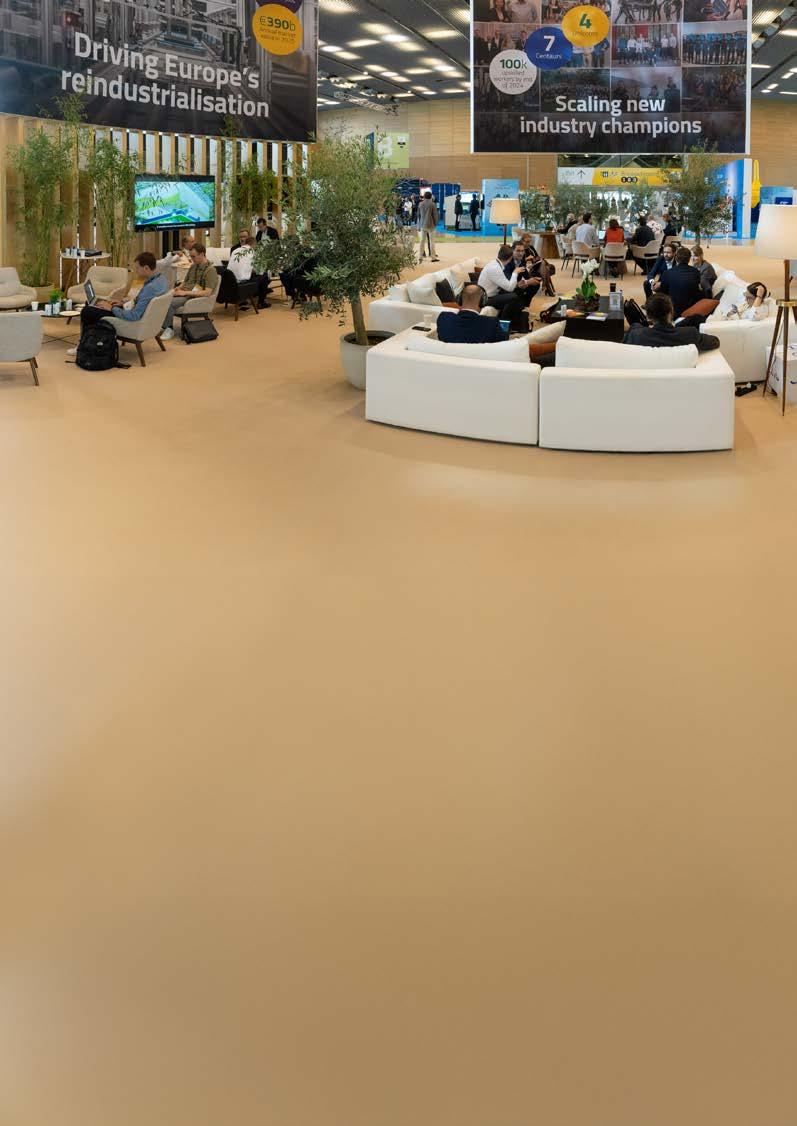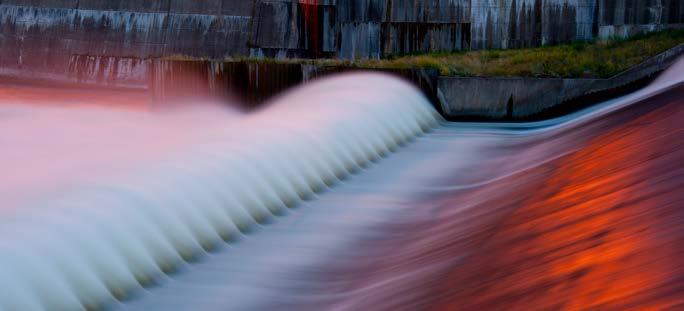

ENERGY TRANSITION, GEOPOLITICAL RESILIENCE, AND ECONOMIC GROWTH
Written by Elena Bou
WHITE PAPER
ENERGY TRANSITION, GEOPOLITICAL RESILIENCE, AND ECONOMIC GROWTH: TRILEMMA OR OPPORTUNITY?
This white paper is a written summary of Elena Bou's TBB2024 presentation.
Elena Bou is Executive Board Member of InnoEnergy. She cofounded InnoEnergy with the idea of transitioning global energy into energy fit for the net-zero economy. In 2023, she was awarded the Nobel Sustainability
Trust’s (NST) Sustainability Award in the category of “Outstanding Research and Development in the Field of Energy“. Elena is also an Associate Professor at ESADE Business School.
InnoEnergy is industrialising clean tech innovation to enable and grow a global net zero economy. We invest in early-stage
companies and the current and future workforce, building resilient clean tech value chains that drive sustainable economic growth. Through the collective power of our ecosystem - with partners spanning industry, finance, public policy, and academia - we scale the energy transition at speed.


EXECUTIVE SUMMARY
• Climate change is increasingly affecting the world, and a green industrial race between the EU, the US, and China has emerged to reverse it. In this Green Industrial Revolution, played right, the energy transition, geopolitical resilience, and economic growth can be an opportunity for Europe and the world.
• Europe has paid a high price to be on track to decarbonise according to targets and take a leading position in several cleantech areas. Other parts of the world have not yet reached the same levels, and worryingly, global energy-related emissions increased last year.
• The US has closed off more of its domestic market, and China relies on the EU market for exporting costeffective clean technologies. European regulatory stability must continue to develop to ensure domestic organisations compete levelheadedly with foreign ones.
• The Draghi report explains the structural problem of the EU Single Market and how it must continue to develop its productivity and competitiveness. Challenges include a lack of disruptive technology, insufficient incentives for developing cleantech champions, and bridging the gap between startups and established industries.
• InnoEnergy is positioned to further the energy transition in Europe and globally by continuing to build on the proven ecosystem growth formula. To succeed and secure our welfare, environment, and freedom, developing innovative cross-border collaborations, sharing knowledge, and creating new opportunities are needed.
Energy transition, geopolitical resilience, and economic growth: Trilemma or opportunity?
INTRODUCTION
A green industrial race has emerged between the European Union (EU), the United States (US), and China. Through aggressive green industrial policies targeted at cleantech, each region seeks to strengthen their position in the global value chains. The EU has built a robust regulatory framework, the US has developed a strong financial support scheme, and China is a market leader in several climate technologies. In short, policy is now aimed at reindustrialisation, energy security, and global competitiveness.
Simultaneously, decarbonisation efforts are more important than ever following an energy crisis in Europe, floods in the Sahara Desert, a rapid increase of wildfires in the US1, more extreme and frequent heat waves in Asia2, and annual increments of global temperatures to unprecedented levels. Before climate change becomes irreversible, we must find a different way of inhabiting Earth. The biggest— and potentially fastest—impact we can make is changing how we power our energy demand.
The manufacturing of climate technology is a sector of growing strategic and economic importance to achieving
climate targets. How can the EU succeed in the energy transition—the Green Industrial Revolution—while leveraging
❝
The biggest—and potentially fastest—impact we can make is changing how we power our energy demand.
economic and geopolitical interests? Is it a trilemma or an opportunity for Europe?

THE GREEN INDUSTRIAL REVOLUTION: TRILEMMA OR OPPORTUNITY?
Clean energy transition
In response to the urgency of the energy transition, climate targets are now embedded in European laws, providing stability and a robust business case for investors. The EU Green Deal has injected dynamism into the Single Market, particularly on the demand side, creating favourable market conditions for innovators and fostering the growth of cleantech in Europe. The US Inflation Reduction Act (IRA) is set to direct federal funding of close to $400BN into clean energy3 and incentivise consumers to choose clean energy alternatives and investors to fund equipment and fuel for the clean energy transition4 Since 2010, the number of emerging technology companies addressing climate issues has quadrupled in Europe and North America5. In 2023, 43% of all global venture capital investments in climate technology were made in Europe6.
The European community is indeed on track to decarbonise. The EU’s deployment of clean technologies is increasing, and greenhouse gas emissions keep decreasing in the region. However, the EU accounted for only 6.1% of global greenhouse gas emissions in
20237. That same year, global energy-related emissions unfortunately grew by 1.1%8, signalling that the international community still has a long way to go. Some countries are falling behind, while others, like China, are making significant progress. Last year, China accounted for over 60% of the total global added capacity for renewables9
❝
The individual progress is promising, but the bigger ecosystem is essential for the global energy transition to succeed at speed.
Meanwhile, the US is further ahead in areas such as AI, and China has made leaps in renewables and EVs. The individual progress is promising, but the bigger ecosystem is essential for the global energy transition to succeed at speed, from supplying technical components to skills and finding effective product-market fit for clean energy products. While each region shapes their markets for clean energy, the next steps must be finding more ways to collaborate across borders, allowing fair competition, knowledge-sharing, and new opportunities.
Geopolitical resilience
The current global landscape is reshaping economic strategies and priorities. In a context of geopolitical uncertainty, governments are concerned with critical dependencies in their supply chains, particularly regarding technological and industrial capabilities. To mitigate these risks, industrial policy has returned in the form of subsidies, diversification of partnerships and suppliers, and proactive economic security strategies.
Europeans are leaders in renewables, offshore and marine energy, recycling, and hydrogen, among others. The continent’s strong technological position has created a fertile environment for further advancements. Europe has also successfully built ecosystems involving entire value chains and stakeholders.
In reaction to China’s growing power in critical sectors such as cleantech, the US implemented protectionist measures through the IRA in 2022, effectively closing off its market. Since China’s domestic market is stagnating, the European market became the primary destination for Chinese exports of electric vehicles (EVs), photovoltaic cells (PVs), and lithium-ion batteries – baptised by the Chinese government as the ‘New Three’ key technologies for economic growth. Europe was the largest recipient of Chinese EVs in 2023, reaching nearly 40% of electric cars exported10
Energy transition, geopolitical resilience, and economic growth: Trilemma or opportunity?

The demand for renewables will only increase in the coming years, raising concerns about the EU’s economic security. While European companies have maintained the highest standards and do not rely on state aid, they have also borne higher energy costs, often lengthy and more complex permitting processes, and increased compliance expenses. Europeans take pride in their free market and welcome competition from third countries, but competition must be on a level playing field.
❝
recently, on October 4th, the Commission set up to 45% tariffs on EVs imported from China11. China’s reaction to the tariffs has been significantly more assertive than its responses to similar actions by the US or Canada because of Europe’s internal fragmentation and dependency on China, reflecting the bloc’s vulnerabilities.
Europe urgently needs to continue its efforts to mitigate these vulnerabilities. While there will be a high price for de-risking, inaction
While there will be a high price for derisking, inaction will be far more costly.
technologies, defence, and climate tech. The EU needs resilient supply chains, considering not only cost, delivery and quality but also the geopolitics of commercial transactions. Stakeholders should explore partnerships and consider not only the sources of raw materials but also the possibility of developing the European Green Deal as a global project that promotes clean industrialisation in third countries.
In response to the US protectionism and the flooding of Chinese cleantech in European markets, the Commission introduced the Green Deal Industrial Plan in 2023, a regulation aimed at securing 40% of European manufacturing capacity. Most
will be far more costly. The European community must prioritise creating innovation and sustainable ecosystems, strengthening cooperation and circularity, and building Europe’s capacities beyond US leadership. There is vast potential in dual-use

Economic growth
The Draghi report on European competitiveness highlights that “there is no EU company with a market capitalisation over EUR 100 billion that has been set up from scratch in the last fifty years,”12 indicating a structural problem in the Single Market. Europe’s economic growth has fallen behind that of the US, China, and other competitors, primarily due to productivity and competitiveness issues. Even without subsidies, the cost of many products from
contrast, it is usually below 10% in China and can reach 2 to 3% in well-established production lines13 14 . The challenges are diverse. First, while the EU’s R&D efforts are comparable to those of the US, Europe is caught in a ‘middle-tech trap.’ This trap involves continuous investment in mature technologies with limited potential for disruption, leaving Europe vulnerable to faster-paced technological advancements elsewhere. High energy prices are also
Second, Europe has not sufficiently incentivised the development of cleantech champions. The concept of first-mover advantage has often been a disadvantage in the EU. Countries like the US create incentives and subsidies for pioneers at an early stage, encouraging innovation. Still, Europe tends to adopt a wait-and-see approach with innovators, leaving investors in uncertainty. Stakeholders must address the issue of growth financing in Europe, where private and public sectors need to collaborate and adopt a less risk-averse approach.
‘There is no EU company with a market capitalisation over EUR 100 billion that has been set up from scratch in the last fifty years,’ indicating a structural problem in the Single Market. ❞
China would remain lower due to their scale, technological leadership and integration with digital tools. For instance, the scrap rate for battery production in Europe can increase to 40%, depending on the production stage. In
hindering economic growth, particularly in energy-intensive industries, and the EU will lack a competitive edge if it continues to rely on fossil fuels. Investing in disruptive technologies is essential to enhance competitiveness.

Lastly, Europe’s next steps must bridge the gap between startups and established industries, which also require modernisation. The European community needs a genuine Single Market with more guarantees, manufacturing skills, and commercially viable innovation by leveraging Europe’s large pool of innovators. Like previous ones, this industrial revolution will be driven by choices made by companies, innovators, and consumers. Creating the right market conditions is crucial, and policymakers must support stakeholders in making informed decisions. The EU can achieve better outcomes than anticipated by fostering a culture of innovation and investment.

Energy transition, geopolitical resilience, and economic growth: Trilemma or opportunity?
THE GREEN TRANSITION OPPORTUNITY
Europe is at a crucial time in history. Since the Green Deal was announced, followed by policy packages like Fit for 55, the Critical Raw Materials Act, and the Net-Zero Industry Act (NZIA), Europe has witnessed a tremendous cleantech demand. The NZIA aims for the Union’s overall strategic net-zero technologies manufacturing capacity to approach or reach at least 40% of annual deployment needs by 2030. That same year, the global market for netzero technology is projected to be worth €600 billion annually, creating millions of new jobs. This development presents a significant market opportunity for businesses. The Commission’s strategic commitment to the green transition is expected to equip the bloc with the necessary tools to achieve strategic autonomy and enable Europe

to effectively respond to industrial policies in the US, epitomised by the IRA, or in China, showcased by its statefunded ‘New Three.’
The new Commission has promised continuity with the Green Deal and decarbonisation policies from five years ago, and the sustainable energy innovation community’s role is to remain staunch defenders
InnoEnergy and our stakeholders and partners have been at the forefront of European climate developments since 2010. We take pride in our portfolio, which has the potential to reduce CO2 emissions in Europe by 30% if scaled up effectively. InnoEnergy is poised to invest in portfolio sectors experiencing difficulties, expedite the closing of investment rounds, and channel funds from investors to portfolio companies. Our dedication lies with the pioneers of climate technology, and we are determined to support them fully. We will pragmatically address financial challenges, establish mechanisms and new EU and US operations, and launch
❝
We need your support to achieve our common goals, not only for the environment but also for our welfare and freedom. ❞
of the EU economy in the upcoming term. As the Draghi report highlights, “We have reached the point where, without action, we will have to either compromise our welfare, our environment, or our freedom.”15 It is crucial that Europe stays at the forefront of the clean transition to remain competitive on a global scale. There are challenges ahead; energy is expensive, and Europe has some critical dependencies, but decarbonisation and competitiveness can go hand in hand. The Commission, private actors, and the whole European innovation ecosystem have a common goal that, if aligned, will make the Green Industrial Revolution a great opportunity.
initiatives through our skills institute to build and enhance necessary skills.
We will spearhead finding new ways to collaborate across borders, share knowledge and learnings, and create new opportunities. However, InnoEnergy cannot achieve the green transition alone. The public, private, and academic sectors all need to be part of the solution. The entire ecosystem must support our entrepreneurs, who stand at the top because of the robust support system beneath them. We need your support to achieve our common goals, not only for the environment but also for our welfare and freedom.
References
1. National Integrated Drought Information System (NIDIS). (2023). Study Finds Climate Change to Blame For RecordBreaking California Wildfires. https://www.drought.gov/ news/study-finds-climatechangeblame-record-breakingcalifornia-wildfires-2023-08-08.
2. Oxford University Press: Oxford Academic, BioScience. (2024). The 2024 state of the climate report: Perilous times on planet Earth. https:// academic.oup.com/bioscience/ article/74/12/812/7808595.
3. McKinsey & Company. (2022). The Inflation Reduction Act: Here’s what’s in it. https://www. mckinsey.com/industries/publicsector/our-insights/the-inflationreduction-act-heres-whats-in-it
4. U.S. Department of the Treasury. The Inflation Reduction Act’s Benefits and Costs. https://home.treasury.gov/news/ featured-stories/the-inflationreduction-acts-benefits-andcosts
5. The Economist. (2023). Climate tech: bridging the gap between innovation and impact. https://impact. economist.com/sustainability/ net-zero-and-energy/ climate-tech-bridging-thegap-betweeninnovation-andimpact?source=post_ page40dfe9132bef.
6. Hamilton, A. (2024). European Climate Tech in 2023. Dealroom. co. https://dealroom.co/blog/ europeanclimate-tech-in2023#:~:text=Europe%20has%20 seen%20a%20rapid,seen%20 in%202023%20of%2043%25.
7. European Commission. (2024). GHG emissions of all world countries. EDGAR - Emissions Database for Global Atmospheric Research. https://edgar.jrc. ec.europa.eu/report_2024
8. International Energy Agency. (2024). CO2 Emissions in 2023.

https://www.iea.org/reports/co2emissions-in-2023/executivesummary.
9. QERY. (2024). Renewable Energy Capacity Tracker. https:// qery.no/renewable-energycapacitytracker/#:~: text=China%20also%20led%20 in%20terms,added%2031%20 GW%20during%202023.
10. Martin, N. (2024). From solar to EVs: How China is overproducing green tech. DW. https://www.dw.com/ en/from-solar-to-evs-howchina-is-overproducing-greentech/a-68782157.
11. Race, M. (2024). EU hits China with big taxes in electric car sales battle. BBC. https:// www.bbc.com/news/articles/ cly20n4d0g9o.
12. Mario, D. (2024). The future of European competitiveness –A competitiveness strategy for Europe. Report for the European Commission. https://commission. europa.eu/topics/strengtheningeuropeancompetitiveness/ eu-competitiveness-lookingahead_en.
13. Keen, K. (2022). Battery scrap projection for recycling plummets – Circular Energy Storage exec. S&P. https://www.spglobal.com/ marketintelligence/en/newsinsights/latest-news-headlines/ batteryscrap-projection-forrecycling-plummets-8211circular-energy-storageexec-71007327.
14. Bernhart, W. (2023). Battery Monitor 2022: Battery production and Product performance. Roland Berger. https://www. rolandberger.com/en/Insights/ Publications/Battery-Monitor2022-Battery-productionandProduct-performance.html.
15. Mario, D. (2024). The future of European competitiveness –A competitiveness strategy for Europe. Report for the European Commission. https://commission. europa.eu/topics/strengtheningeuropeancompetitiveness/ eu-competitiveness-lookingahead_en
InnoEnergy
Kennispoort 6th floor
John F. Kennedylaan 2 5612 AB Eindhoven The Netherlands info@innoenergy.com
InnoEnergy Benelux
Kennispoort 6th floor
John F. Kennedylaan 2 5612 AB Eindhoven The Netherlands benelux@innoenergy.com
InnoEnergy Brussels Rue Guimard 7 1040 Brussels info@innoenergy.com
InnoEnergy Central Europe ul. Mogilska 43 31–545 Kraków, Poland central.europe@innoenergy.com
Transitioning global energy. Transforming every industry.
ul. Chmielna 73 00-801 Warszawa, Poland central.europe@innoenergy.com
InnoEnergy France 5 rue du Louvre 75001 PARIS, France france@innoenergy.com
5 place Nelson Mandela 38000 Grenoble, France france@innoenergy.com
InnoEnergy Germany
Albert-Nestler-Strasse 21 76131 Karlsruhe, Germany germany@innoenergy.com
Zionskirchstr. 73a 10119 Berlin, Germany germany@innoenergy.com
www.innoenergy.com
InnoEnergy Iberia
Carrer Jordi Girona, 29 0C Nexus II building 08034 Barcelona, Spain iberia@innoenergy.com
Paseo de la Castellana, 259D, 18th fl. 28046 Madrid, Spain iberia@innoenergy.com
InnoEnergy Scandinavia
Torsgatan 11, 8th floor 111 23 Stockholm, Sweden scandinavia@innoenergy.com
InnoEnergy USA
444 Somerville Ave Somerville, Massachusetts 02143 United States usa@innoenergy.com
